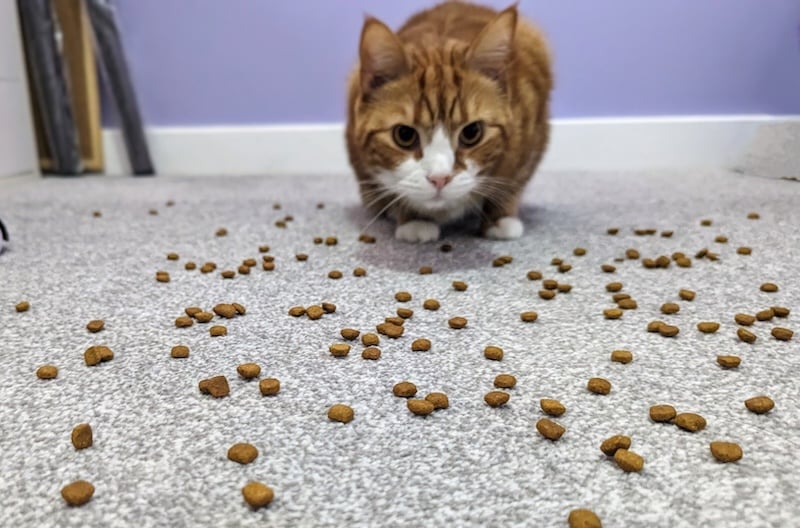Cats love to play! Playing with your cat can be one of the most enjoyable parts of ownership, and it doesn’t stop when your kitten grows up. Not only is it good exercise, it’s also a good way to strengthen your friendship with your pet. But it can also take some practice to find your cat’s favorite ways to play and get them moving every day.
These tips will help you get started in exploring the types of play your cat might enjoy.
 The 10 Tips to Play With Your Cat
The 10 Tips to Play With Your Cat
1. Play Every Day
Play isn’t just for fun—it’s also your cat’s biggest form of exercise. Cats that play daily are more likely to stay in good health throughout their lives. Spending time playing with your cat has social benefits too. Even just spending a few minutes playing every day will help your cat be happier, healthier, and less bored. Playing with your cat at the same time every day can also make the playtime easier because cats love schedules and can get excited for playtime ahead of time.

2. Choose Safe Toys
It’s important to choose the right toys when playing, and that means considering your cat’s safety. Avoid toys that your cat might swallow and choke on, especially bits of string that can end up tangled in your cat’s digestive system. Make sure your toys aren’t small enough for your cat to eat or made of a material they can bite chunks out of.
3. Don’t Make Your Hands Prey
It can be tempting to use whatever toy is at hand, including your own fingers! If your cat seems to enjoy stalking or attacking your hand, it’s best to break that habit, though. Even gentle play bites and scratches can sometimes hurt. Cats can also start to see your hands as toys and go into “play mode” whenever you try to pet them or pick them up. It’s much better to stick with designated cat toys.

4. Learn Your Cat’s Active Times
Cats have a natural wake/sleep cycle just like humans, and most cats have a daily routine with high and low energy times. If you notice your cat is more playful at certain times of the day, you can use that to your advantage. Common high-energy times include early morning, evenings, and around mealtimes. You’re much more likely to have a successful playtime with your cat during these times.
5. Keep Sessions Short
Kittens have seemingly endless energy, but adult cats generally like to play in short bursts. Keeping play sessions short will help them get their exercise in without overtiring them. Expect to spend about 5–15 minutes at a time playing with your cat and stop if its energy seems to flag. You might be able to start another play session after a short rest, though—it depends on the cat.

6. Include Solo and Interactive Options
Interactive play with toys like feather wands or (safe) light beams is an important part of play, but it’s not the only way for your cat to get exercise. Make sure your cat also has access to solo play toys so it can burn off some energy when you’re not around. Catnip mice, ball track toys, and puzzle boxes are common toys that your cat can enjoy when you’re not around.
7. Keep Up the Variety
Cats like occasional changes in toys, and a new type of play can be new and exciting. Wand toys, fetch toys, puzzle toys, and other types of toys can keep things interesting. You can also vary up your play space—like throwing a blanket over a chair to make a new place for your cat (and toy) to hide. Most toys need regular replacement as they become worn, and while some cats have a favorite toy type, you can also try occasional new toys to keep things varied.

8. Motivate With Treats
If you’ve got a couch potato that doesn’t ever want to engage in active play, it’s okay to “train” your cat to play with treats. One of the best ways to get a sedentary cat to play is through a puzzle toy with treats inside it. You can also train your cat to expect a treat every time it catches a feather wand or fetches a toy. It’s important to keep the treats to a healthy amount, though, and not overfeed your cat.
9. Keep Toys Moving
Cats are attracted to movement, and often a toy isn’t very interesting if it’s sitting still. You can gently toss or roll small toys, twitch a string or a wand, and let a toy sway back and forth to get your cat’s attention. You can also experiment with moving a toy in and out of sight, hiding it behind a piece of furniture or a blanket, and then letting it peek out again to keep your cat excited.

10. Engage All the Senses
Playing isn’t just visual. Cats love a multisensory experience. Toys with jingle bells, crinkly noises, different textures, and catnip scents are all great options. You can also make sure you have a variety of colors and textures available in your toybox. It can take some trial and error to find out what your cat’s favorite sounds, scents, and textures are when it comes to toys, but it’s well worth it.
 Last Thoughts
Last Thoughts
Whether you want to play with your cat as a form of mental stimulation, exercise, or just to have some fun together, you’re making a good call. Playing with your cat regularly is one of the best things you can do for your cat. And it’s also a whole lot of fun! We hope that these tips will help you build up a great toolkit of play skills to keep your cat happy and engaged.
Featured Image Credit: Oleg Ivanov, Unsplash






